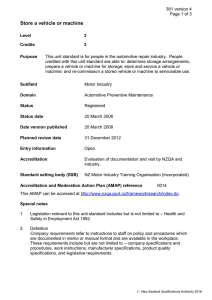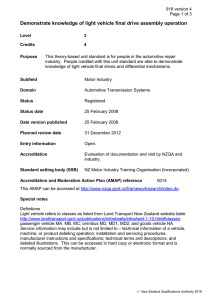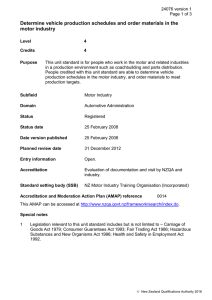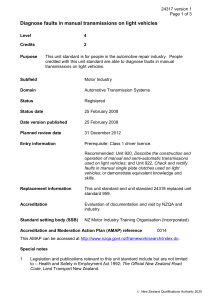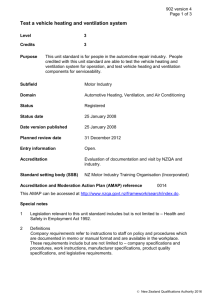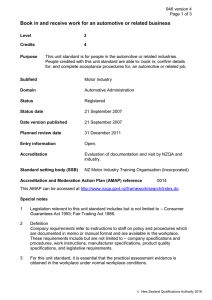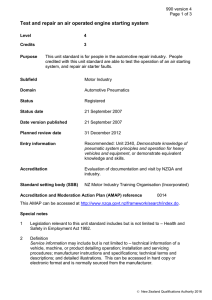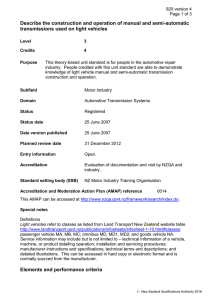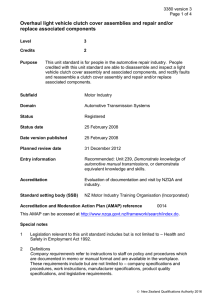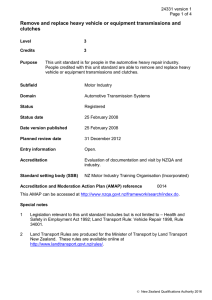Demonstrate knowledge of the construction and operation of heavy
advertisement
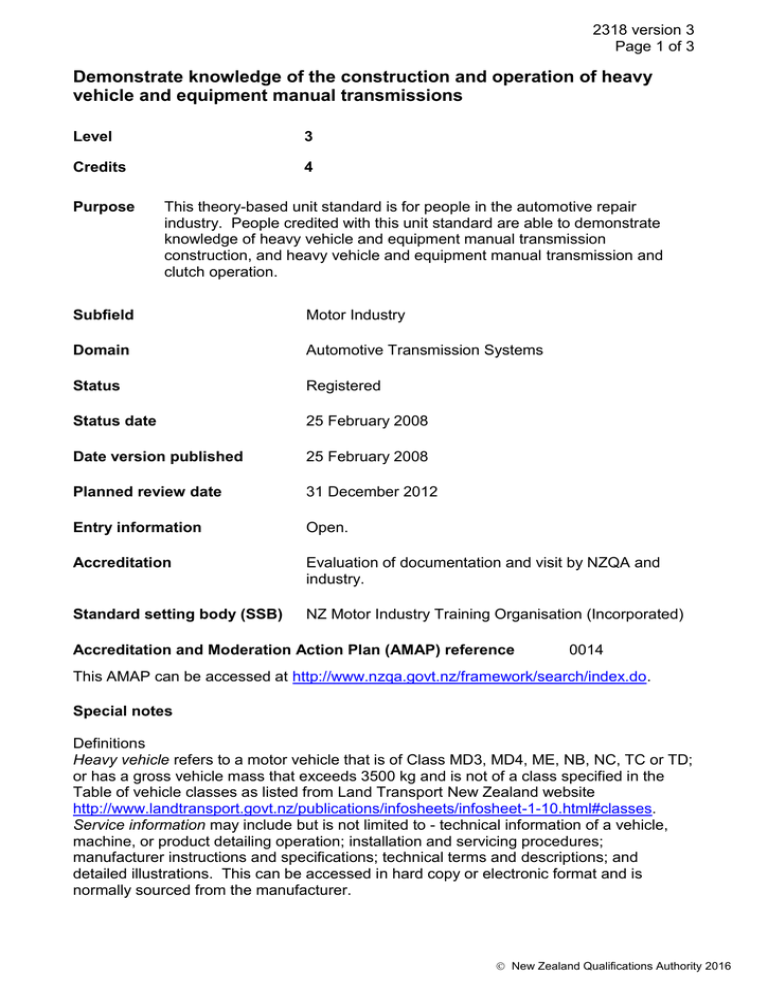
2318 version 3 Page 1 of 3 Demonstrate knowledge of the construction and operation of heavy vehicle and equipment manual transmissions Level 3 Credits 4 Purpose This theory-based unit standard is for people in the automotive repair industry. People credited with this unit standard are able to demonstrate knowledge of heavy vehicle and equipment manual transmission construction, and heavy vehicle and equipment manual transmission and clutch operation. Subfield Motor Industry Domain Automotive Transmission Systems Status Registered Status date 25 February 2008 Date version published 25 February 2008 Planned review date 31 December 2012 Entry information Open. Accreditation Evaluation of documentation and visit by NZQA and industry. Standard setting body (SSB) NZ Motor Industry Training Organisation (Incorporated) Accreditation and Moderation Action Plan (AMAP) reference 0014 This AMAP can be accessed at http://www.nzqa.govt.nz/framework/search/index.do. Special notes Definitions Heavy vehicle refers to a motor vehicle that is of Class MD3, MD4, ME, NB, NC, TC or TD; or has a gross vehicle mass that exceeds 3500 kg and is not of a class specified in the Table of vehicle classes as listed from Land Transport New Zealand website http://www.landtransport.govt.nz/publications/infosheets/infosheet-1-10.html#classes. Service information may include but is not limited to - technical information of a vehicle, machine, or product detailing operation; installation and servicing procedures; manufacturer instructions and specifications; technical terms and descriptions; and detailed illustrations. This can be accessed in hard copy or electronic format and is normally sourced from the manufacturer. New Zealand Qualifications Authority 2016 2318 version 3 Page 2 of 3 Elements and performance criteria Element 1 Demonstrate knowledge of heavy vehicle and equipment manual transmission construction. Performance criteria 1.1 The types of gears used in manual transmissions are identified in accordance with service information. Range spur, helical. 1.2 The application of spur and helical gears are explained in accordance with service information. 1.3 The component parts of selector mechanisms are identified, and their function described, in accordance with service information. Range 1.4 Methods of lubricating gears, bearings and bushes are described in accordance with service information. Range 1.5 rails, forks, detents, interlocks, reverse lockout, gear selection control. pressure fed, splash, sealed, impregnated. Shaft layouts and locations are described in accordance with service information. Range single, twin, triple countershaft units. Element 2 Demonstrate knowledge of heavy vehicle and equipment manual transmission and clutch operation. Performance criteria 2.1 The power flow paths for single, twin and triple countershaft units are described in accordance with service information. 2.2 The purpose and operation of a syncromesh unit are described in accordance with service information. 2.3 The operation of manual transmissions is described in accordance with service information. Range main gearbox, epicylic gear train, range change, splitter. New Zealand Qualifications Authority 2016 2318 version 3 Page 3 of 3 2.4 Clutch assembly operation is described in accordance with service information. Range single and dual dry clutch packs, power take off (PTO) clutches, clutch adjustments, clutch levers, shift control system. Please note Providers must be accredited by NZQA, or an inter-institutional body with delegated authority for quality assurance, before they can report credits from assessment against unit standards or deliver courses of study leading to that assessment. Industry Training Organisations must be accredited by NZQA before they can register credits from assessment against unit standards. Accredited providers and Industry Training Organisations assessing against unit standards must engage with the moderation system that applies to those standards. Accreditation requirements and an outline of the moderation system that applies to this standard are outlined in the Accreditation and Moderation Action Plan (AMAP). The AMAP also includes useful information about special requirements for organisations wishing to develop education and training programmes, such as minimum qualifications for tutors and assessors, and special resource requirements. Comments on this unit standard Please contact the NZ Motor Industry Training Organisation (Incorporated) info@mito.org.nz if you wish to suggest changes to the content of this unit standard. New Zealand Qualifications Authority 2016
